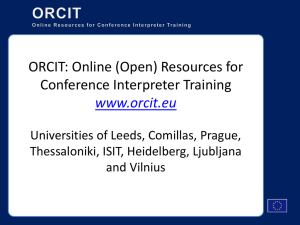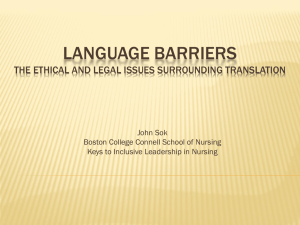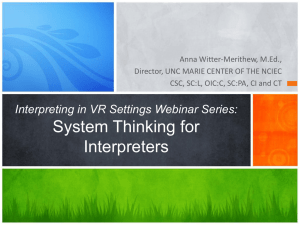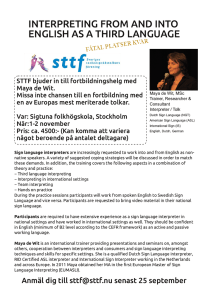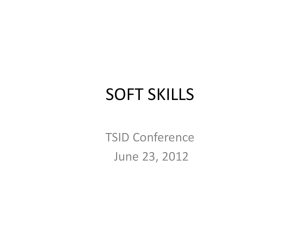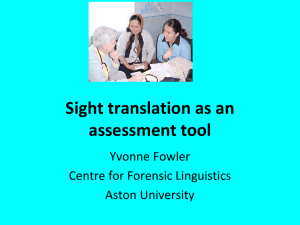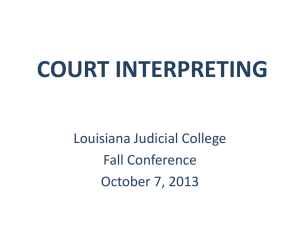invisible process?
advertisement
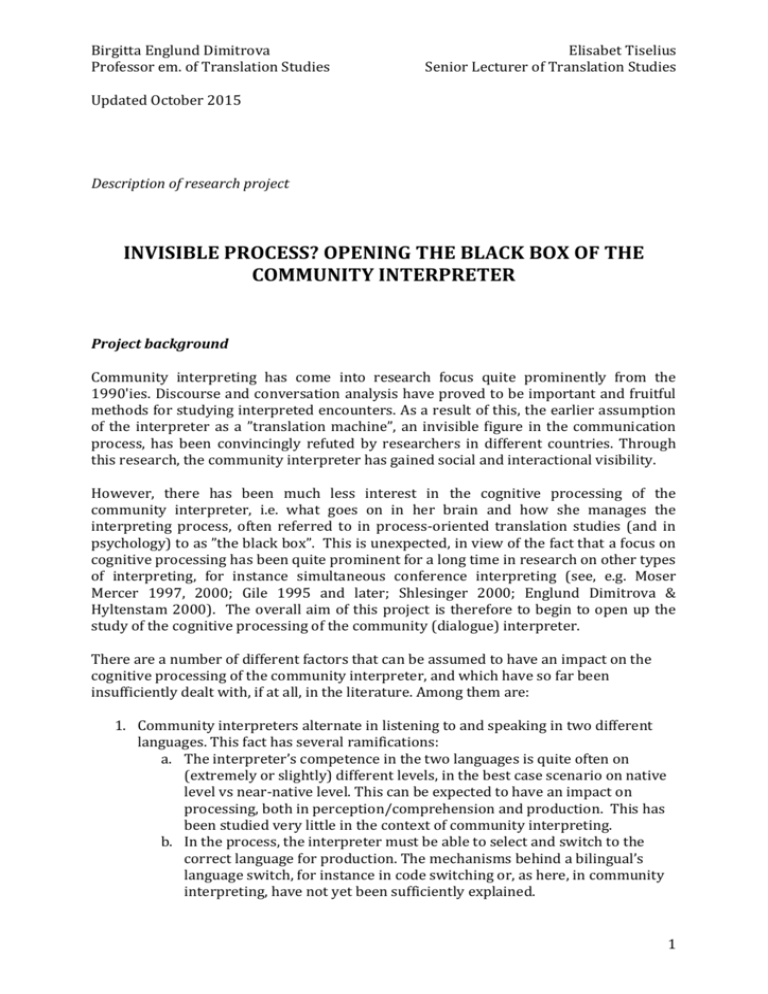
Birgitta Englund Dimitrova Professor em. of Translation Studies Elisabet Tiselius Senior Lecturer of Translation Studies Updated October 2015 Description of research project INVISIBLE PROCESS? OPENING THE BLACK BOX OF THE COMMUNITY INTERPRETER Project background Community interpreting has come into research focus quite prominently from the 1990'ies. Discourse and conversation analysis have proved to be important and fruitful methods for studying interpreted encounters. As a result of this, the earlier assumption of the interpreter as a ”translation machine”, an invisible figure in the communication process, has been convincingly refuted by researchers in different countries. Through this research, the community interpreter has gained social and interactional visibility. However, there has been much less interest in the cognitive processing of the community interpreter, i.e. what goes on in her brain and how she manages the interpreting process, often referred to in process-oriented translation studies (and in psychology) to as ”the black box”. This is unexpected, in view of the fact that a focus on cognitive processing has been quite prominent for a long time in research on other types of interpreting, for instance simultaneous conference interpreting (see, e.g. Moser Mercer 1997, 2000; Gile 1995 and later; Shlesinger 2000; Englund Dimitrova & Hyltenstam 2000). The overall aim of this project is therefore to begin to open up the study of the cognitive processing of the community (dialogue) interpreter. There are a number of different factors that can be assumed to have an impact on the cognitive processing of the community interpreter, and which have so far been insufficiently dealt with, if at all, in the literature. Among them are: 1. Community interpreters alternate in listening to and speaking in two different languages. This fact has several ramifications: a. The interpreter’s competence in the two languages is quite often on (extremely or slightly) different levels, in the best case scenario on native level vs near-native level. This can be expected to have an impact on processing, both in perception/comprehension and production. This has been studied very little in the context of community interpreting. b. In the process, the interpreter must be able to select and switch to the correct language for production. The mechanisms behind a bilingual’s language switch, for instance in code switching or, as here, in community interpreting, have not yet been sufficiently explained. 1 Birgitta Englund Dimitrova Professor em. of Translation Studies Elisabet Tiselius Senior Lecturer of Translation Studies Updated October 2015 2. In research on simultaneous conference interpreting, an important topic has been how the interpreter allocates her (limited) set of attentional resources. Cognitively, the processing in community interpreting is requires the interpreter’s attention for a number of tasks, not only perception, comprehension, transfer and production, but also: a. deciding when to take notes, and do so in a prudent way (selectively); b. monitoring the interaction process with the conversation participants, in order to manage it as well as the cognitive interpreting process 3. Capacity of working memory (cf. for conference interpreting Timarová 2012) 4. A number of external factors already found to have an impact on other types of interpreting can be assumed to be important in the context of community interpreting as well. These include, e.g., acoustic quality, speed and mode of delivery of the talk, participants’ accent and prosody, the linguistic complexity of the utterances to be interpreted, etc. A number of speech phenomena have been used in studies of simultaneous interpreting in order to gain access to features of the cognitive processing (hesitation, false starts, filled and unfilled pauses, etc.) Such phenomena could be systematically studied in the production of community interpreters as well. Aims of the project The project aims are: - to analyze salient aspects of the communicative process of particular relevance for the cognitive processing - to propose a model of the cognitive processing of the (professional) community interpreter, incl. a competence model, taking into account process-oriented research on other types of interpreting - to probe into the cognitive processing of the community interpreter through two kinds of data o psycholinguistic experiments with professional community interpreters and interpreter students o videorecordings of interpreted encounters elicited from semi-scripted roleplays both with professional community interpreters and interpreter students Abstracts of papers within the project Joint paper by Englund Dimitrova and Tiselius ”Cognitive aspects of community interpreting. Toward a process model” (submitted for publication, May 2015) This paper discusses cognitive aspects of professional community interpreting. We give an overview of earlier research into community interpreting, arguing that cognitive aspects have largely been neglected. We propose that in building a model of the mental 2 Birgitta Englund Dimitrova Professor em. of Translation Studies Elisabet Tiselius Senior Lecturer of Translation Studies Updated October 2015 processes of the community interpreter, different kinds of monitoring are a crucial and pervasive component, contributing to and enabling the double function of the interpreter, both to translate and to manage the interaction of the interpreted encounter. We furthermore stress the importance of the notion of professional selfconcept for explaining the interpreter's decision-making, and exemplify this by analyzing turn-taking in two Swedish-Spanish interpreted encounters. Conference presentation by Tiselius at inDialog conference in Berlin, November, 2015 ”Investigating the cognitive processes of Community interpreters: a feasible task?” In order to investigate Community Interpreting earlier research have stressed the need to study the whole communicative event. This requirement possibly contradicts the possibility of studying cognition and the interpreting process as previous studies on the interpreting process have, to a great extent, only covered the interpreter’s perspective of the communicative event. By only looking at the interpreter’s perspective it is possible that research might overlook other important factors for the community interpreting situation (such as the other parties). Could an investigation of the community interpreting process include other participants’ cognition, or, does it become so complex (depending upon the level of detail) that it risks not allowing it to be tested empirically? Yet, studying the community interpreter’s cognition is necessary, and probably perfectly possible and relevant, as long as the other participants’ cognitive behaviour is also accounted for appropriately in the models and data. Furthermore, it could possibly be done from the perspective of the interpreter and his/her central position as an acting and reacting human and professional, in an interaction with at least two other primary parties. The presentation will look into different possibilities of investigating the Community Interpreter’s process and cognition in the context of the interpreter mediated event. This is part of the preparatory phase of an empirical research project on the Community interpreter’s cognitive processes. Project time plan 2014 2015, January May, 2015 November, 2015 2016 Project start Joint presentation at 4th Translation Process Research Workshop in Las Palmas. Title: ”Cognitive aspects of competence in community interpreting. Theoretical and methodological considerations” Joint paper: ”Cognitive aspects of community interpreting: toward a process model” (submitted for publication) Paper by Elisabet Tiselius: ”Investigating the cognitive processes of Community interpreters: a feasible task?” at inDialog conference in Berlin. Paper by Englund Dimitrova: ”Cognitive load in community interpreting. A reinterpretation of some earlier findings” (work 3 Birgitta Englund Dimitrova Professor em. of Translation Studies Elisabet Tiselius Senior Lecturer of Translation Studies Updated October 2015 2016 2016 2016, Autumn 2017 2017-2018 in progress) Paper by Tiselius and Englund Dimitrova: Don’t community interpreters have a ”black box”? Approaching a missing link in community interpreting research Application for funding Planning psycholinguistic experiments and elicited videorecordings Psycholinguistic experiments and elicited video-recordings with professional community interpreters and student interpreters Analysis, reports International cooperation The project is discussing plans for cooperation with the project ”MH Medical interpreting project” led by Dr Helen Tebble, Adjunct Associate Professor at Monash University, Melbourne, Australia, with participation of Dr Jim Hlavac, Senior Lecturer Monash in cooperation with health care and research staff at Monash Health, Melbourne, Australia. Birgitta Englund Dimitrova Professor em. of Translation Studies Institute for Interpreting and Translation Studies, Department of Swedish Language and Multilingualism Stockholm University SE-106 91 Stockholm Sweden Birgitta.Englund@su.se Elisabet Tiselius Senior Lecturer Translation Studies (focus on interpreting) Institute for Interpreting and Translation Studies, Department of Swedish Language and Multilingualism Stockholm University SE-106 91 Stockholm Sweden elisabet.tiselius@su.se Bergen university college (Dept. of sign language and interpreting) Karolinska institutet (Dept. of women’s and children’s health, Childhood cancer healthcare research) 4
